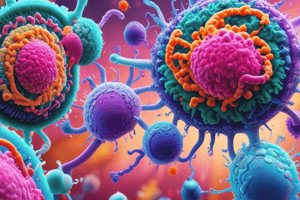Podcast
Questions and Answers
What is the temperature range that can generally inactivate heat?
What is the temperature range that can generally inactivate heat?
- 56-60°C for 30 minutes (correct)
- 60-70°C for 30 minutes
- 70-80°C for 1 hour
- 50-55°C for 1 hour
What is the pH range that can destroy most viruses?
What is the pH range that can destroy most viruses?
- pH below 5 and alkaline pH above 9 (correct)
- pH below 3 and alkaline pH above 11
- pH below 6 and alkaline pH above 8
- pH below 4 and alkaline pH above 10
What is unique about the glycerol's effect on viruses and bacteria?
What is unique about the glycerol's effect on viruses and bacteria?
- Both viruses and bacteria survive 50% glycerol
- Viruses are destroyed by 50% glycerol, while bacteria survive
- Both viruses and bacteria are destroyed by 50% glycerol
- Bacteria are destroyed by 50% glycerol, while viruses survive (correct)
What type of agents are most effective against viruses?
What type of agents are most effective against viruses?
What is the main characteristic that distinguishes viruses from bacteria in terms of reproduction?
What is the main characteristic that distinguishes viruses from bacteria in terms of reproduction?
What is the composition of a virion?
What is the composition of a virion?
How are viruses classified based on their host specificity?
How are viruses classified based on their host specificity?
What is the definition of virology?
What is the definition of virology?
What is the term for the entire infectious unit of a virus?
What is the term for the entire infectious unit of a virus?
What is essential for a virus to replicate?
What is essential for a virus to replicate?
What is the function of the capsid?
What is the function of the capsid?
What is the effect of viral antiserum on the virion?
What is the effect of viral antiserum on the virion?
What is a characteristic of viruses?
What is a characteristic of viruses?
What is the result of treating viral nucleic acid with ribo- or deoxyribonuclease?
What is the result of treating viral nucleic acid with ribo- or deoxyribonuclease?
What is a by-product of the viral replicative cycle?
What is a by-product of the viral replicative cycle?
What is missing from all viruses?
What is missing from all viruses?
What is the primary reason why large viruses of the pox group can be seen using ordinary light microscopes?
What is the primary reason why large viruses of the pox group can be seen using ordinary light microscopes?
What is the purpose of mixing a virus suspension with a suspension of polystyrene latex particles of known concentration in electron microscopy?
What is the purpose of mixing a virus suspension with a suspension of polystyrene latex particles of known concentration in electron microscopy?
What is responsible for the increased limit of resolution in electron microscopes compared to light microscopes?
What is responsible for the increased limit of resolution in electron microscopes compared to light microscopes?
What is the primary application of the fluorescent antibody technique in virology?
What is the primary application of the fluorescent antibody technique in virology?
What is the function of structured proteins in viruses?
What is the function of structured proteins in viruses?
What is the minimum diameter of virus particles that can be resolved by electron microscopes?
What is the minimum diameter of virus particles that can be resolved by electron microscopes?
What is the advantage of using electron microscopes over light microscopes in virology?
What is the advantage of using electron microscopes over light microscopes in virology?
What can be recognized using the fluorescent antibody technique and electron microscopy in infected animals or humans?
What can be recognized using the fluorescent antibody technique and electron microscopy in infected animals or humans?
What is the primary function of the structural proteins of a virus?
What is the primary function of the structural proteins of a virus?
How can the structural proteins of a virus be studied?
How can the structural proteins of a virus be studied?
What type of nucleic acid do most major families of RNA-containing animal viruses have?
What type of nucleic acid do most major families of RNA-containing animal viruses have?
Which of the following viruses is an exception to the rule that DNA-containing animal viruses have double-stranded DNA genomes?
Which of the following viruses is an exception to the rule that DNA-containing animal viruses have double-stranded DNA genomes?
What is the function of the enzyme reverse transcriptase in RNA tumor viruses?
What is the function of the enzyme reverse transcriptase in RNA tumor viruses?
What is the purpose of the protein hemagglutinin in influenza virus?
What is the purpose of the protein hemagglutinin in influenza virus?
How can the type of nucleic acid and strandedness be determined?
How can the type of nucleic acid and strandedness be determined?
What is a characteristic of the structural proteins of many viruses?
What is a characteristic of the structural proteins of many viruses?
Which virus causes cytomegalic inclusion disease?
Which virus causes cytomegalic inclusion disease?
What is the characteristic of Poxviridae family?
What is the characteristic of Poxviridae family?
Which virus is associated with several human malignancies?
Which virus is associated with several human malignancies?
What is the characteristic of Picornaviridae family?
What is the characteristic of Picornaviridae family?
Which virus is the most common cause of colds in humans?
Which virus is the most common cause of colds in humans?
What is the characteristic of Reoviridae family?
What is the characteristic of Reoviridae family?
Which virus is an agent of infantile gastroenteritis?
Which virus is an agent of infantile gastroenteritis?
What is the characteristic of Varicella-zoster virus?
What is the characteristic of Varicella-zoster virus?
Flashcards are hidden until you start studying
Study Notes
Characteristics of Viruses
- Viruses are inactivated by temperatures of 56-60°C for 30 minutes
- pH affects viral survival, with most viruses destroyed at pH below 5 and above 9
- Glycerol affects viruses and bacteria differently, with 50% glycerol surviving most viruses but destroying bacteria
- Bactericidal agents, such as Phenol, are not efficient as viral disinfectants, whereas oxidizing agents are most effective against viruses
- Antibiotics and chemotherapeutic agents, like Sulfonamides, penicillin, streptomycin, and tetracyclines, have little effect on viruses
Reproductive Processes
- Viral reproductive processes differ from bacterial binary fission
- Viruses contain only one kind of nucleic acid, which is covered by a protein coat
Definition of Virology
- Virology is the branch of microbiology that deals with viruses and viral diseases
Nature of Viruses
- Viruses are minute infectious agents that are not resolved in the light microscope
- They lack independent metabolism and replicate only within living host cells
- They have genetic continuity and the possibility of mutation
- They are morphologically heterogeneous, occurring as rod-shaped, spherical, or polyhedral forms
- Viruses are composed of a nucleic acid (the nucleoid), DNA or RNA (but not both), and a protein shell or capsid
- The protein shell contains and protects the nucleic acid
- Viruses are classified according to host specificity, origin, mode of transmission, or the manifestation they produce
Viral Structure
- The individual particle or virion consists of nucleic acid and a protein shell or capsid
- Capsid: a symmetric protein shell that encloses the nucleic acid genome
- Nucleocapsid: the capsid together with enclosed nucleic acid
- A virion lacks certain components essential for its replication and must depend on the host cell for these missing factors
- One component missing from all viruses is an ATP-generating system
Microscopy
- Although most viruses cannot be seen by ordinary microscopic methods, the light microscope has some important applications in virology
- Large viruses of the pox group can be demonstrated by staining procedures
- The fluorescent antibody technique is valuable for demonstrating viral antigens in tissues
- Electron microscopy has brought even the smallest viruses into visible range and is capable of resolving particles with diameters of less than 1 nm
Chemical Composition of Viruses
- Viral Protein: serves to protect the viral genome, participate in attachment to susceptible cells, and determines the antigenic characteristics of the virus
- Virus structural proteins may be very specialized molecules designed to perform specific tasks
- Viral Nucleic Acid: contains a single kind of nucleic acid, either DNA or RNA, that encodes the genetic information necessary for the replication of the virus
- Viral Lipids: some viruses contain lipids as part of their structure
Virus Families
- Poxviridae Family: relatively large, brick-shaped or ovoid viruses containing a double-stranded DNA genome and protein, enveloped by double membranes
- Picornaviridae Family: small, ether-resistant viruses that contain single-stranded RNA
- Reoviridae Family: ether-resistant viruses that contain double-stranded RNA
Studying That Suits You
Use AI to generate personalized quizzes and flashcards to suit your learning preferences.




